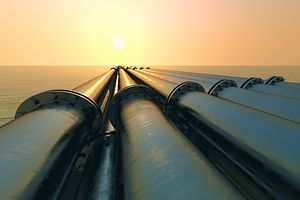Last week the energy leads from Turkmenistan, Azerbaijan, Turkey, and the European Union gathered in Ashgabat to reaffirm their mutual commitment to building out the infrastructure necessary to transport Turkmen gas to Europe.
“Europe expects supplies of Turkmen gas to begin by 2019,” Marcos Sefcovic, the European Commission vice president in charge of the energy union initiative, said after the meetings concluded.
In a declaration adopted Friday, the four parties that met in the Turkmen capital–Yagshygeldi Kakayev, the director of the state agency for management and use of hydrocarbon resources in Turkmenistan; Natig Aliyev, the Azeri minister of energy; Taner Yildiz, the Turkish minister of energy and mineral resources; and Sefcovic for the EU–outlined the next steps toward making the Trans-Caspian Pipeline (TCP) a reality.
Europe and Turkmenistan are keen to diversify their energy import and exports, respectively, and for reasons associated with the same country: Russia. Europe currently gets a third of its natural gas from Russia, a relationship complicated by Russian involvement in Ukraine. Turkmenistan once relied on Russia as a major destination for its gas, but as Chris Rickleton wrote for Eurasianet in February, deliveries of Turkmen gas to Russia have dropped “from a peak of around 45 billion cubic meters per year (bcm) in 2008 to the 4 bcm the Russian giant says it will now import in 2015.” Russia’s canceling of the South Stream project, which was to supply Europe from Russia, earlier this year decidedly benefited Turkmen initiatives and the European market helps the country also diversify from its current trajectory as a main gas line for China.
The recent declaration from Turkmenistan, Azerbaijan, Turkey and the EU is not so much a deal–through the Iranian press calls it that–as a promise of potential future deals. The parties committed to facilitating “joint efforts for the preparation of the draft of a legal Framework Agreement on natural gas supply from Turkmenistan to Europe,” and establishing a Working Group to examine the legal and logistical hurdles that come with any large pipeline initiative.
These developments come at an auspicious time.
In March, construction on the Trans-Anatolian Pipeline (TANAP) officially began. TANAP is expected to be completed by 2018 and will bring Azeri gas from the Georgian border, through Turkey to the Greece and the European market. The completion of TANAP is necessary as it forms the largest piece of the southern gas corridor, this is the pipeline Turkmenistan hopes to link into. TANAP is to initially transport 16 billion cubic meters of gas and increase to 60 bcm. Azerbaijan, notes RFE/RL “cannot produce that much gas for export, so Turkmenistan, with more than 17 trillion cubic meters of gas, is an obvious choice to contribute to TANAP.”
Incidentally, Turkmenistan’s East-West Pipeline (EWP), which will bring gas from the country’s fields in the southeast to the edge of the Caspian, is to be completed this year and will carry 30 bcm, the same amount it hopes to transport through the TCP. In addition, Turkmenistan has already agreed to framework with Turkey to supply TANAP.
Also, a competing pipeline to transport Turkmen gas east–through Afghanistan and Pakistan to India (TAPI), has been set back, again. Afghan President Ashraf Ghani commented that construction on TAPI would take five years–setting the opening of flows back two years from previous estimates, to 2020. As Casey Michel noted, with the drying up the the Russian market–Gazprom cut imports from Turkmenistan again, from 11 billion cubic meters to four–TAPI seemed like the only feasible option. “Until it wasn’t.”
Progress in the negotiations between the P5+1 and Iran have given Europeans hope of adding Iranian gas to their supply. There has been mention of building a pipeline from Turkmenistan through Iran and onward west to Europe. Iran sits atop the world’s largest gas reserves and Turkmenistan the fourth largest.
Turkmen gas flowing into Europe, however, is far from certain. Both politics and logistics may get in the way. Turkmenistan, in order to hook into TANAP will need to build a 300-km (187-mile) pipeline under the Caspian’s disputed waters. The Caspian’s maritime borders are disputed between the sea’s five littoral states–Azerbaijan, Iran, Turkmenistan, Kazakhstan and Russia. As one of the central purposes of building the pipeline is to circumvent Russia, it’s not hard to imagine Moscow playing a spoiler in delineating the waters.
































